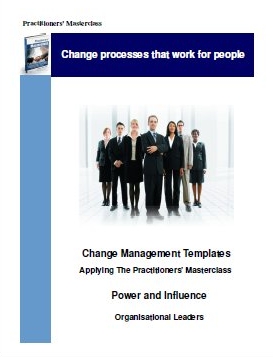|
Change Management Templates For CEOsStarting Out
The "Why" is fully covered in the Practitioners Masterclass You have an idea, you have a vision for a significant visionary change, and/or your organisation is facing major external challenges… It is fairly obvious to you that the size, scope and complexity, priority, timescale and strategic importance of the proposed change is such that it is a step change, and as such should not be introduced as part of "Business As Usual" as it would disrupt the day-to-day running of your organisation. It is also apparent that if this potential change initiative is to proceed, it needs to be regarded and handled as a specific initiative and will require some form of change management process. The change management templates for CEOs are extracts from Change Management Templates - Change Processes That Work For People Change management templates for CEOs identify six key steps in each phase of your change initiative:
Factors that are usually ignored or unacknowledged, and that undermine and significantly increase the likelihood of failure at each phase
The "one big thing" - a specific action or event that if instigated at this phase has major positive leverage on the change initiative
The defined successful outcome of the critical action point at this phase
The attitudes and behaviours within yourself, your management peers and your organisation that will offer resistance and seek to undermine you at this phase
Early informal feedback indicators Here are the specifics of each of these steps that you will face in the starting out phase of your change management initiative.
Stalling Points[1] Failure to understand your role
[2] Failure to understand what has and hasn’t worked before
[3] Failure to understand the role and critical importance of your informal networks
Critical Action Point
Key Questions
Initial ObjectiveYour initial objective is to reach a shared perspective of a high level view of each of the following points:
This not a negotiation, this is not a planning exercise, this is an informal discussion. It is highly likely that this will involve a number of meetings of the “informal” group – each of the above points could involve a separate session. Get your formal team to meet with your informal team.
What is most likely to go wrong?Problems are likely to arise from 3 areas: [1] Your fellow directors and other senior management colleagues Your fellow directors and other senior management colleagues will probably not initially understand what you are doing or why. They will put you under pressure to move more quickly, to delegate as soon as possible, and unconsciously they will recoil from the idea of the loss of control – and the perception of the loss of power - in involving so many "outsiders" or "at least until we are clear what we are doing". [2] Members of the informal organisation If you have not involved members of the informal organisation in prior change initiatives, and if you and/or your organisation have a poor track record on running change initiatives then they will likely be suspicious or even hostile to your initial invitation to meet and talk informally. They will be trying to figure out what your hidden agenda is and may be reluctant to participate and will stall you. [3] You The change you seek within your organisation starts with you! An adaptive approach to change leadership means that you as leader have to be prepared to change first. This may mean admitting past mistakes – mistakes that may have disrupted and negatively impacted the personal and emotional lives of many people. Your leadership style quite likely has to change. You are now an enabler and facilitator. If your psychological and emotional profile matches that of the typical business leader , whilst you may intellectually agree with some of what you have just read, you will quite probably experience a degree of resistance.
Quick metrics on progress
Further ResourcesThere are a further 5 key phases of your change management initiative that are identified and addressed in the change management templates for CEOs:
For more information on the 6 key steps in each of these phases please see: Change Management Templates For CEOs
Return to "Change management articles and resources
|


 Change management templates for CEOs are about the real-life practical details of "How" to lead change.
Change management templates for CEOs are about the real-life practical details of "How" to lead change.

